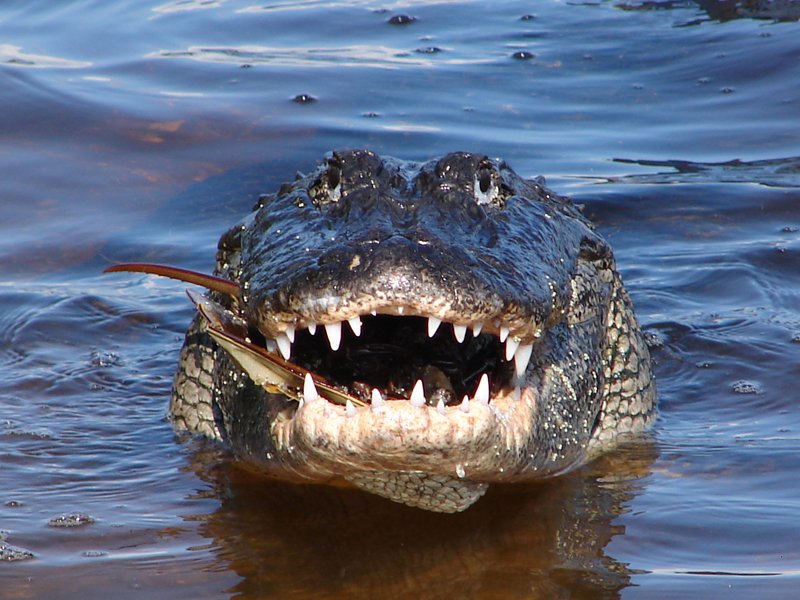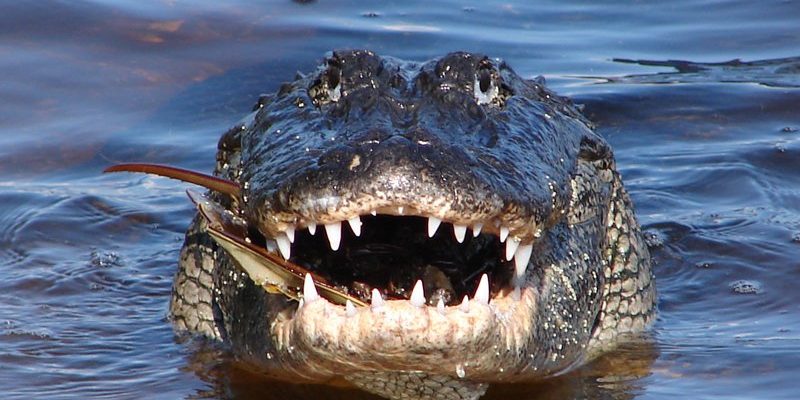
Honestly, the more you learn about the American alligator, the more you realize there’s a lot to uncover. They might seem intimidating, but they have unique traits that tell a deeper story. So, grab a cup of coffee, and let’s dive into ten surprising things you didn’t know about these remarkable creatures.
1. They’re Living Fossils
You might be wondering what I mean by “living fossils.” Well, the American alligator has been around for millions of years, surviving the same mass extinction that wiped out the dinosaurs. While their ancestors roamed the Earth about 200 million years ago, today’s alligators remain remarkably similar to them.
This ancient lineage means that alligators are one of the closest living relatives to dinosaurs. Isn’t it wild to think you’re looking at a creature that has persisted through such a vast stretch of time? They really are a snapshot of history, reminding us of how life can endure in varying environments.
Adaptations for Survival
To survive through such drastic changes in climate and habitat, alligators have developed some incredible adaptations. For example, their strong jaws can crush bones, and their tough skin is covered in armor-like scales. But they also have a unique ability to regulate their body temperature by basking in the sun or soaking in the cool water.
This resiliency is something that makes alligators fascinating to study, as they provide insights into how life can thrive even in harsh conditions. They remind us that survival often means adjusting to our surroundings.
2. They Can Hold Their Breath for Over an Hour
Think you’d run out of breath fast in water? Alligators have an impressive ability to hold their breath for up to two hours! This skill is essential for their hunting strategies. They often lie in wait underwater, just below the surface, using their eyes and nostrils positioned on the tops of their heads to spot prey while remaining mostly hidden.
Imagine floating in a pool with your eyes just above water, watching everything around you without anyone noticing. That’s how alligators hunt, and it’s highly effective. They can sneak up on fish, birds, and even mammals that come too close to the water’s edge.
How They Breathe
You might be curious how they manage to hold their breath for so long. Alligators have specialized lungs that allow them to exchange oxygen efficiently. They can also slow their heart rate while submerged, reducing their oxygen consumption.
This unique adaptation not only helps them hunt but also protects them from potential threats. It’s a brilliant survival strategy that keeps them at the top of the food chain.
3. They Have a Unique Communication System
While you might think alligators are silent, they have their own way of “talking” to each other. They use a series of vocalizations, including growls, hisses, and even bellows. These sounds can help establish territory, attract mates, or warn others of danger.
If you’ve ever heard an alligator bellow, it’s quite something! It’s a deep, resonating sound that can travel miles. This communication system is particularly important during mating season when males need to attract females and establish dominance among rivals.
Understanding Alligator Behavior
Listening to these vocalizations can tell you a lot about what alligators are up to. For instance, a loud bellowing might indicate that a male is claiming his territory. It’s like a baritone serenade in the bayou! By understanding their communication, we can learn more about their social structures and behaviors in the wild.
4. They Are Cold-Blooded Creatures
Being cold-blooded means that alligators rely on their environment to regulate their body temperature. They can’t produce their own body heat, so you’ll often find them basking in the sun—or seeking cool waters when it gets too hot.
This behavior isn’t just for comfort; it’s essential for their metabolic processes. When temperatures drop, alligators become sluggish and less active, which can make them more vulnerable to predators. This is why you might see them sunning themselves on a warm rock, making sure they’re ready for a day of hunting or simply enjoying their environment.
Seasonal Changes
As seasons change, so do the alligators’ behaviors. During the colder months, they may enter a state of brumation, similar to hibernation, where their metabolism slows down considerably. They often stay in dens or burrows to stay warm, showing just how adaptable they are to their surroundings.
5. Their Diet Is Diverse
You might picture alligators as purely meat-eaters, but they actually have a surprisingly varied diet. They are opportunistic feeders, which means they’ll eat what’s readily available. This can include:
- Fish
- Birds
- Mammals
- Snakes
- Even fruit, on occasion!
It’s fascinating to think that a creature so feared can also munch on a piece of fruit. This flexibility in diet helps them survive in changing environments, as they can adapt based on what food sources are available.
Hunting Techniques
Alligators can hunt with a variety of techniques. They might ambush prey from underwater or actively chase it down. Their powerful jaws and ability to perform a “death roll” help them catch and consume prey. This adaptability makes them efficient predators in their ecosystems.
6. They Play a Role in Their Ecosystem
Alligators aren’t just top predators; they’re also considered a keystone species. This means that they play a crucial role in maintaining the health of their ecosystems. Their burrowing creates habitat for other animals, and their hunting keeps prey populations in check.
By maintaining a balance within their environment, they help promote biodiversity. For example, when alligators create holes in the water, these become mini-ecosystems for smaller creatures and plants to thrive. It’s like they’re nature’s gardeners!
Protecting Wetlands
Wetlands, where alligators are commonly found, are essential for filtering water and providing habitats for countless species. By protecting their populations, we’re also helping to preserve these vital ecosystems that benefit both wildlife and humans.
7. They Can Live for Over 70 Years
If you think alligators live short lives, think again! In the wild, they can live for more than 70 years, and some in captivity have been known to exceed 80 years. This longevity is impressive and helps them play their role in the ecosystem for decades.
It’s interesting to consider how a creature can witness so many changes in its environment over a long lifespan. Older alligators can also display different behaviors than younger ones, which can be important in understanding their social dynamics.
Reproductive Habits
Alligators reach maturity at around 6 to 13 years old, depending on environmental factors like temperature and food availability. They start breeding in the spring and lay their eggs in nests built from vegetation. Female alligators are known to be protective mothers, guarding their nests and even helping the hatchlings to water once they emerge.
8. They Can Regenerate Teeth
Have you ever lost a tooth and wished you could have it back? Alligators have a remarkable ability to regenerate their teeth. They lose about 2,000 teeth over their lifetime but can replace them continuously throughout their lives.
This is crucial for their ability to hunt and eat effectively. If they lose a tooth while catching prey, a new one is ready to grow in its place. It’s like having a dental plan that lasts forever!
How Teeth Grow Back
Each replacement tooth grows from a socket located deeper in the jaw. When an alligator loses a tooth, the socket sends signals to trigger the growth of a new tooth, sometimes even before the old one has fallen out completely. This natural process makes them incredibly efficient hunters.
9. They Are Important for Cultural Heritage
In many Southern cultures, the alligator is more than just a creature of the swamp; it’s a symbol of strength and resilience. From folklore to art, alligators hold a special place in the hearts of many communities.
For example, in Louisiana, alligator hunting and farming are part of the cultural economy, showcasing how local heritage intertwines with the presence of these reptiles. Alligator products can be found in cuisine, fashion, and even in art, celebrating their significance and the connection between people and nature.
Respect and Conservation
As we appreciate this unique cultural significance, it’s essential to recognize the importance of alligator conservation. Overhunting and habitat loss have posed threats to their populations. Many organizations work tirelessly to protect alligators and their ecosystems, ensuring future generations can enjoy these remarkable animals.
10. Alligators Are More Social Than You Think
Despite their reputation as solitary hunters, alligators can be surprisingly social creatures. They often gather in groups during basking times and communicate with each other through sounds and body language.
These groups can be called “congregations,” where alligators may engage in social behaviors such as play or fighting for dominance. It’s like seeing a family reunion of sorts—where some are basking peacefully, and others are asserting their place in the hierarchy.
Social Bonds
Some research suggests that alligators may recognize each other and form bonds over time. It’s fascinating to think of them as more than just fierce predators; they have a social structure that can influence their behavior and interactions.
As we wrap up, it’s clear that the American alligator is not just a scary creature lurking in the waters but a complex, fascinating part of our ecosystem and culture. They remind us that there’s always more to learn about the wildlife around us. So next time you see an alligator, you might just appreciate it a little more!

